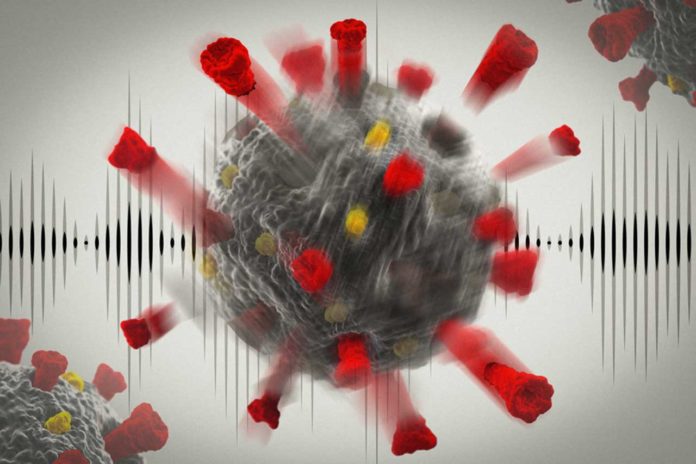Like other coronaviruses, SARS-CoV-2 particles are spherical and have proteins called spikes protruding from their surface. These spikes latch onto human cells, then undergo a structural change that allows the viral membrane to fuse with the cell membrane. The viral genes can then enter the host cell to be copied, producing more viruses.
Studies have shown that the virus that caused the 2002 SARS outbreak, SARS-CoV-2 spikes bind to receptors on the human cell surface called angiotensin-converting enzyme 2 (ACE2).
A recent study by MIT scientists has suggested that ultrasound vibrations can potentially damage coronaviruses. The ultrasound vibrations should be within the frequencies used in medical diagnostic imaging.
Scientists used computer simulations to model the virus’s response to vibrations across a range of ultrasound frequencies. They identified that vibrations between the range of 25 and 100 megahertz triggered the virus’s shell and spikes to collapse and start to crack inside a fraction of a millisecond. This impact was found in simulations of the virus in the air and water.
Scientists noted, “The results are preliminary, and based on limited data regarding the virus’ physical properties. Nevertheless, the findings are the first hint at a possible ultrasound-based treatment for coronaviruses, including the novel SARS-CoV-2 virus.”
The next target for the scientists includes understanding how ultrasound could be administered and determining its effectiveness in damaging the virus within the complexity of the human body.
Tomasz Wierzbicki, professor of applied mechanics at MIT, said, “We’ve proven that under ultrasound excitation the coronavirus shell and spikes will vibrate, and the amplitude of that vibration will be very large, producing strains that could break certain parts of the virus, doing visible damage to the outer shell and possibly invisible damage to the RNA inside. The hope is that our paper will initiate a discussion across various disciplines.”
Scientists wanted to know more about the virus’s fracture potential. They, thus, simulate the novel coronavirus and its mechanical response to vibrations. Using basic mechanics and physics of solids, scientists constructed a geometrical and computational model of the virus’s structure.
With this geometry in mind, the group modeled the virus as a thin elastic shell covered in around 100 elastic spikes. As the virus’ exact physical properties are questionable, the scientists simulated this simple structure’s behavior across a range of elasticities for both the shell and the spikes.
Wierzbicki says, “We don’t know the material properties of the spikes because they are so tiny — about 10 nanometers high. Even more unknown is what’s inside the virus, which is not empty but filled with RNA, which itself is surrounded by a protein capsid shell. So this modeling requires a lot of assumptions.”
“We feel confident that this elastic model is a good starting point. The question is, what are the stresses and strains that will cause the virus to rupture?”
To figure out the answer, scientists introduced acoustic vibrations into the simulations. They started with vibrations of 100 megahertz or 100 million cycles per second. They observed how the vibrations rippled through the virus’s structure across a range of ultrasound frequencies.
The frequency was estimated to be the shell’s natural vibrating frequency based on the virus’s physical properties.
When they exposed the virus to 100 MHz ultrasound excitations, the virus’s natural vibrations were initially undetectable. But within a fraction of a millisecond, the external vibrations, resonating with the frequency of the virus’ natural oscillations, caused the shell and spikes to buckle inward, similar to a ball that dimples as it bounces off the ground.
When there is an increase in the amplitude, intensity, and vibrations, the shell could fracture. At lower frequencies of 25 MHz and 50 MHz, the virus buckled and fractured even faster, both in simulated air and water levels similar in density to fluids in the body.
Wierzbicki said, “These frequencies and intensities are within the range that is safely used for medical imaging.”
Scientists are now collaborating with microbiologists in Spain to refine and validate their findings.
Wierzbicki stresses that there is much more research to be done to confirm whether ultrasound can be an effective treatment and prevention strategy against coronaviruses. As his team works to improve the existing simulations with new experimental data, he plans to zero in on the novel’s specific mechanics, rapidly mutating the SARS-CoV-2 virus.
Wierzbicki said, “We looked at the general coronavirus family, and now are looking specifically at the morphology and geometry of Covid-19. The potential is something that could be great in the current critical situation.”
Journal Reference:
- Tomasz Wierzbicki et al. Effect of receptors on the resonant and transient harmonic vibrations of Coronavirus. DOI: 10.1016/j.jmps.2021.104369
